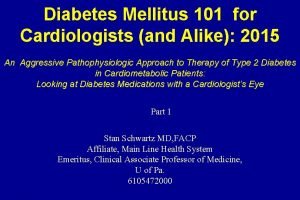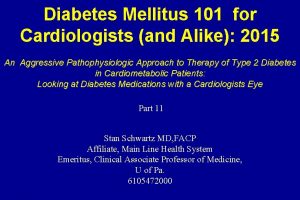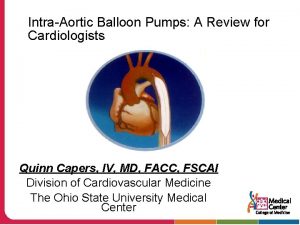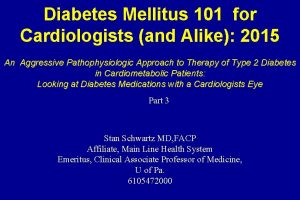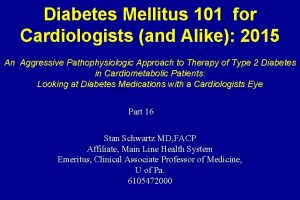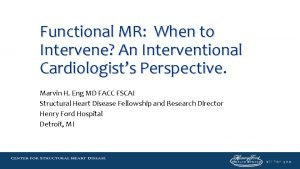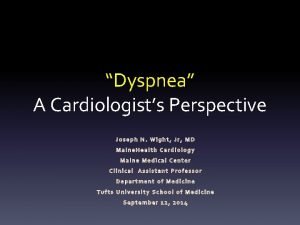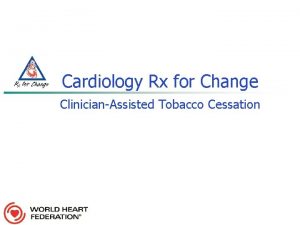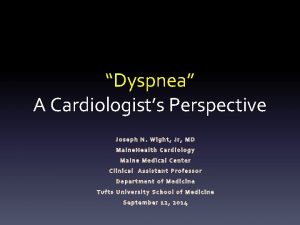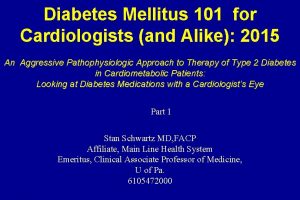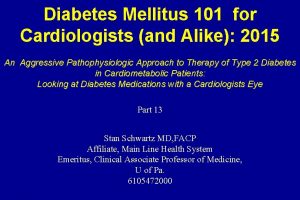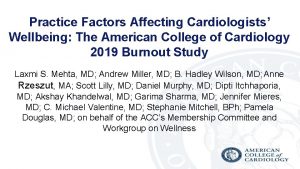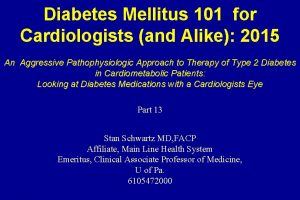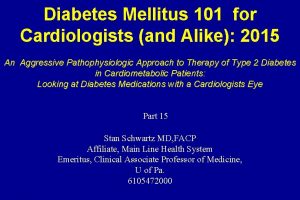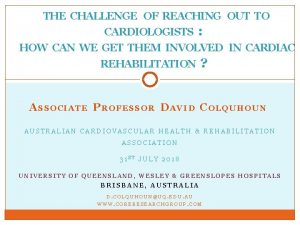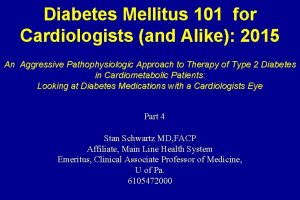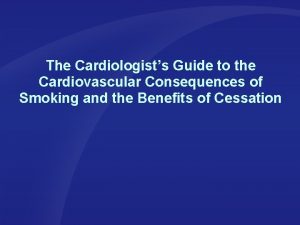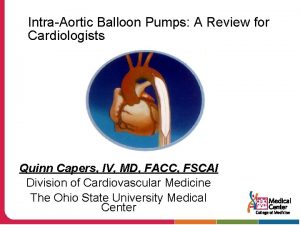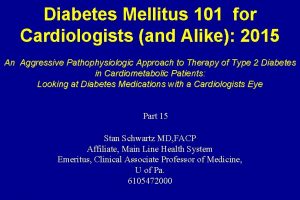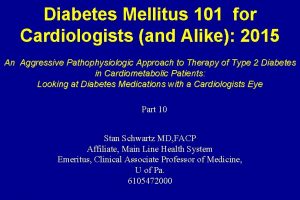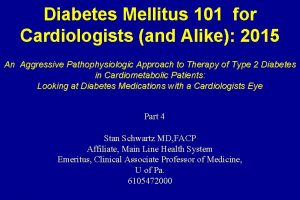Cardiologists Role in EVAR with the Development of
































- Slides: 32

Cardiologists Role in EVAR with the Development of Low Profile Devices J. Michael Bacharach MD MPH FACC Clinical Professor of Medicine University of South Dakota Section Head Vascular Medicine, North Central Heart Institute Sioux Falls South Dakota Associate Professor of Surgery Mayo Clinic Graduate School of Medicine

J. Michael Bacharach, MD, MPH I have no real or apparent conflicts of interest to report.


Dinosaurs Once Ruled The Earth Dinosaurs once ruled the earth. They were bigger, stronger and more powerful then other living creatures ……. But they failed to adapt.

Tradition – defined as…. The handing down of beliefs or customs from one generation to another, especially without writing A belief or custom handed down in this way, a long established custom or method of procedure

Tradition For years the tradition was that surgeons cared for patients with abdominal aortic aneurysms Once identified these patients were followed by surgeons When aneurysms became large enough or symptomatic, they were treated with surgical aneurysmectomy

2/26/1951 Freeman&Leeds (Vein inlay graft) 3/2/1951 Schafer&Hardin (Homograft) 3/13/1953 Bahnson 1 st repair ruptured AAA 1954 Cooley Dacron graft refined 2012: 15 Endovascular devices (5 FDA approved) (2) 14 F devices in Trials Friedman SG. JVS 2001; 33: 895 -898 Yao JST. CV Surg 2003; 11: 413 -5 9/6/1990 Parodi Endo tube graft

Evolution As with most things in the world, the influences of evolution require adaptation to survive Endografts represent an evolution in technology that has resulted in a less invasive method of treating aneurysmal disease

Procedure volume for OSR (surg repair) of AAAs compared with EVAR in the Medicare fee-forservice population, 2001 to 2006. J Am Coll Radiol 2009; 6: 506 -509

Current Utilization of EVAR by Specialty • The combined utilization rate per 100, 000 of the two types of interventions for AAA (EVAR and OSR) decreased from 121 in 2001 to 119 in 2006. In performing EVAR, procedure volume and market share in 2006 by specialty were • 1) 22, 003 procedures by surgeons, a 76% share; • 2) 3, 287 procedures by radiologists, an 11% share; • 3) 1, 915 procedures by cardiologists, a 7% share; and • 4) 1, 732 procedures by all other physicians, a 6% share. J Am Coll Radiol 2009; 6: 506 -509.

Adaptation This change in technology has required a new set of skills Imaging and the recognition that certain aortic morphology is well suited for EVAR and recognizing those who are not Catheter based skills No longer is cutting and suturing required Rather manipulation of small catheters and wires under fluoroscopic guidance and without the aid of direct tactile manipulation

Elements of Management of the Patient With AAA Recognize and diagnose aneurysmal disease Apply appropriate imaging to risk stratify and determine need for intervention Risk factor management and management of co-morbidities Intervention On-going care and surveillance

Components of Treating Patients with Aneurysmal Disease Recognition…. clearly a physician trained to care for patients can through history, examination and adjunctive imaging identify aneurysmal disease Imaging…. requires familiarity with both advances and limitations of modern imaging, and the ability to convert the imaging into data that can be translated into determining the suitability of a patient for endovascular treatment

Components of Treating Patients with Aneurysmal Disease Judgement and experience…. knowing when to say “NO” Catheter-based skills…. needed for procedural success, familiarity with device characteristics and the ability to adapt the best device to achieve the best outcome Surveillance…. commitment to continue to follow and care for the patient after the procedure

Patient Selection Not all aneurysmal disease is suited for endovascular therapy There continues to be aneurysms that do not lend themselves to this type of treatment and still require skilled surgeons to perform open repair

Contribution to the Technology While surgeons have contributed significantly in the development of endovascular aneurysm therapy, it would be disingenuous not to recognize the significant contribution made by cardiologists and radiologists in the development of EVAR into an effective therapy that has significantly reduced the morbidity and mortality associated with traditional surgical treatment.

Development Mature Technology Development Innovation

Percutaneous Endograft Placement 1999


Contained Rupture Rx’ed EVAR

Fenestrated Cook Zenith Graft

Ovation™ Abdominal Stent Graft System Tri-Modular Design 14 F OD PTFE Main Body Low-Viscosity Radiopaque Fill Polymer 13 F OD Iliac Limbs Suprarenal Stent with Anchors for Fixation Polymer Filled Rings for Optimal Sealing Rings Conform to Anatomy

Procedure Characteristics PROCEDURE DATA Total Procedure Time (mins) avg +/- (SD) 109. 9, (41. 4) Device Time (mins) avg +/- (SD) 44. 1, (18. 9) Procedural Blood Loss (cc) avg +/- (SD) 229. 5, (263. 9) ANESTHESIA* General Anesthesia 65. 8% 106/161 Regional Anesthesia 16. 8% 27/161 Local or Conscious Sedation 34. 8% 56/161 PRIMARY VESSEL ACCESS Percutaneous 46. 6% Cut Down 53. 4% * Some patients received more than one type of anesthesia.

The Concept that EVAR is So Complicated That Non-surgeons Cannot do it is Laughable ! But……. It does require adequate commitment and training

These necessary components are not unique to surgeons, but with adequate and appropriate training, can be achieved by cardiologists, vascular medicine specialists and interventional radiologists.

Challenges • Catheter skills are not enough ! • How to change existing training programs to cultivate the necessary cognitive and procedural skill to perform EVAR • It is clearly an advanced level skill and commitment that is required

Rogers' 5 Factors Rogers defines several intrinsic characteristics of innovations that influence an individual’s decision to adopt or reject an innovation. Factor Definition Relative Advantage How improved an innovation is over the previous generation. Compatibility The level of compatibility that an innovation has to be assimilated into an individual’s life. Complexity or Simplicity Trialability being If the innovation is too difficult to use an individual will not likely adopt it. How easily an innovation may be experimented with as it is adopted. I a user has a hard time using and trying an innovation this individual will be less likely to adopt it. Observability The extent that an innovation is visible to others. An innovation that is more visible will drive communication among the individual’s peers and personal networks and will in turn create more positive or negative reactions.

Innovation Curve

Adopter category Definition Innovators are the first individuals to adopt an innovation. Innovators are willing to take risks, youngest in age, have the higher social class, have great financial lucidity, very social and have closest contact to scientific sources and interaction with other innovators. Risk tolerance has them adopting technologies which may ultimately fail. Financial resources help absorb these failures. (Rogers 1962 5 th ed, p. 282) Early Adopters This is the second fastest category of individuals who adopt an innovation. These individuals have the highest degree of opinion leadership among the other adopter categories. Early adopters are typically younger in age, have a higher social status, have more financial lucidity, advanced education, and are more socially forward than late adopters. More discrete in adoption choices than innovators. Realize judicious choice of adoption will help them maintain central communication position (Rogers 1962 5 th ed, p. 283). Early Majority Individuals in this category adopt an innovation after a varying degree of time. This time of adoption is significantly longer than the innovators and early adopters. Early Majority tend to be slower in the adoption process, have above average social status, contact with early adopters, and seldom hold positions of opinion leadership in a system (Rogers 1962 5 th ed, p. 283) Late Majority Individuals in this category will adopt an innovation after the average member of the society. These individuals approach an innovation with a high degree of skepticism and after the majority of society has adopted the innovation. Late Majority are typically skeptical about an innovation, have below average social status, very little financial lucidity, in contact with others in late majority and early majority, very little opinion leadership. Laggards Individuals in this category are the last to adopt an innovation. Unlike some of the previous categories, individuals in this category show little to no opinion leadership. These individuals typically have an aversion to change-agents and tend to be advanced in age. Laggards typically tend to be focused on “traditions”, likely to have lowest social status, lowest financial fluidity, be oldest of all other adopters, in contact with only family and close friends, very little to no opinion leadership.

The Future?

Summary EVAR has replaced open surgical repair for the majority of AAA pts with suitable anatomy Evolution of technology has improved results, extended applications, and in many cases no longer requires surgical based access Cardiologists have superb catheter skills that are well suited for EVAR Existing training programs need to change to cultivate the required cognitive and procedural skills

 Azure worker role
Azure worker role Role making krappmann
Role making krappmann Role conflict occurs when fulfilling the role expectations
Role conflict occurs when fulfilling the role expectations Hát kết hợp bộ gõ cơ thể
Hát kết hợp bộ gõ cơ thể Slidetodoc
Slidetodoc Bổ thể
Bổ thể Tỉ lệ cơ thể trẻ em
Tỉ lệ cơ thể trẻ em Chó sói
Chó sói Thang điểm glasgow
Thang điểm glasgow Chúa sống lại
Chúa sống lại Môn thể thao bắt đầu bằng chữ đua
Môn thể thao bắt đầu bằng chữ đua Thế nào là hệ số cao nhất
Thế nào là hệ số cao nhất Các châu lục và đại dương trên thế giới
Các châu lục và đại dương trên thế giới Công thức tiính động năng
Công thức tiính động năng Trời xanh đây là của chúng ta thể thơ
Trời xanh đây là của chúng ta thể thơ Mật thư anh em như thể tay chân
Mật thư anh em như thể tay chân Phép trừ bù
Phép trừ bù Phản ứng thế ankan
Phản ứng thế ankan Các châu lục và đại dương trên thế giới
Các châu lục và đại dương trên thế giới Thơ thất ngôn tứ tuyệt đường luật
Thơ thất ngôn tứ tuyệt đường luật Quá trình desamine hóa có thể tạo ra
Quá trình desamine hóa có thể tạo ra Một số thể thơ truyền thống
Một số thể thơ truyền thống Cái miệng xinh xinh thế chỉ nói điều hay thôi
Cái miệng xinh xinh thế chỉ nói điều hay thôi Vẽ hình chiếu vuông góc của vật thể sau
Vẽ hình chiếu vuông góc của vật thể sau Nguyên nhân của sự mỏi cơ sinh 8
Nguyên nhân của sự mỏi cơ sinh 8 đặc điểm cơ thể của người tối cổ
đặc điểm cơ thể của người tối cổ V cc
V cc Vẽ hình chiếu đứng bằng cạnh của vật thể
Vẽ hình chiếu đứng bằng cạnh của vật thể Tia chieu sa te
Tia chieu sa te Thẻ vin
Thẻ vin đại từ thay thế
đại từ thay thế điện thế nghỉ
điện thế nghỉ Tư thế ngồi viết
Tư thế ngồi viết

































